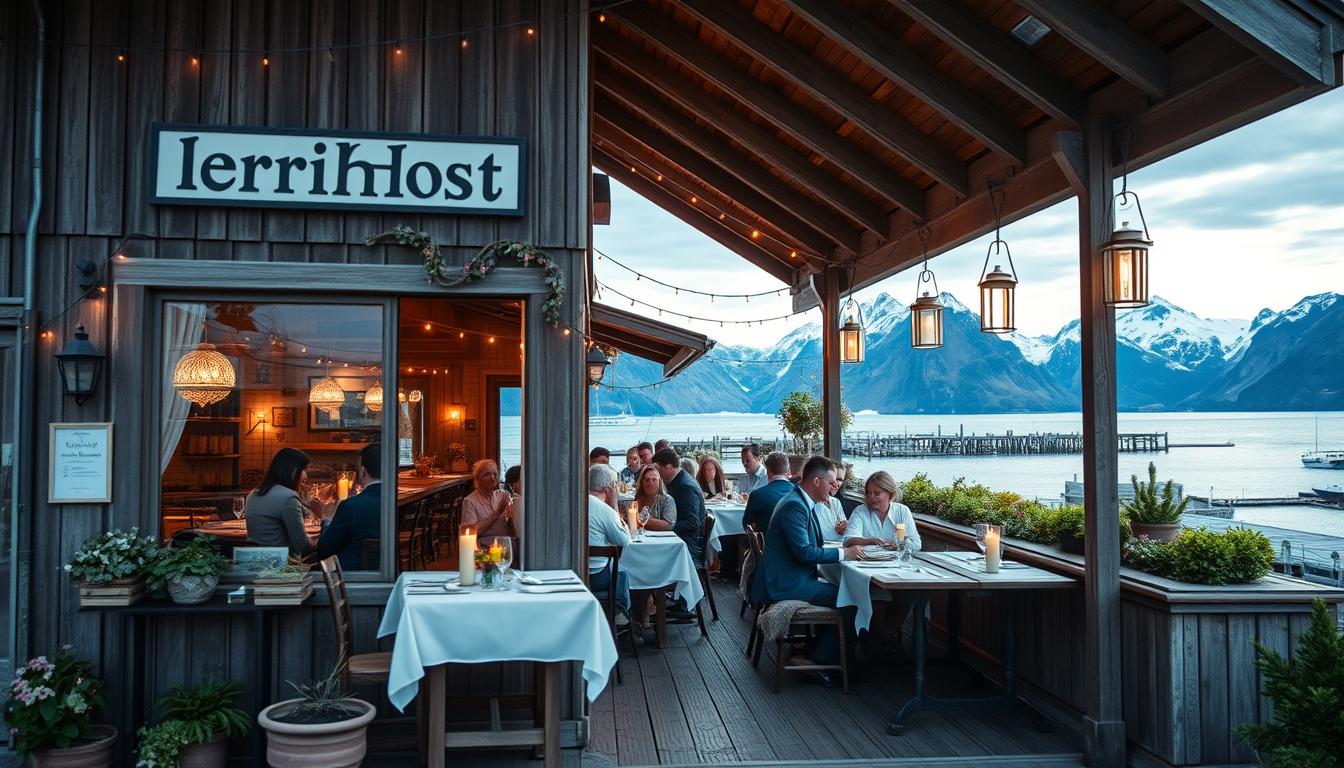Starting a catering business in Norway is an exciting journey for food lovers. The market is growing, making it a great chance for new entrepreneurs. To succeed, we need to know the local market, follow catering laws in Norway, and offer food that our customers will love.
Starting a catering business requires careful planning and hard work. We’ll look at the key steps and things to consider. By focusing on quality and customer service, we can make our business stand out and meet our customers’ needs.
Understanding the Catering Industry in Norway
The Norwegian catering market is full of life, thanks to rich culture and new cooking ideas. More people and companies want catering for events like weddings and corporate parties. They’re not just looking for food; they want a memorable experience.
Overview of the Norwegian Catering Market
The market has grown a lot in recent years. More events mean more need for catering. It offers everything from simple buffets to fancy dinners, meeting different tastes.
Popular Catering Services Offered
Many choose buffet catering for its variety. Plated dinners are popular for their elegance. Meal delivery services are also in demand, for the ease of enjoying quality food at home.
Trends in Norwegian Cuisine
Now, there’s a big focus on using local, seasonal ingredients. This celebrates Norway’s farms and seas. It’s important to mix old recipes with new ways of cooking. Creative presentation makes dishes look as good as they taste, showing off both new and traditional Norwegian food.
Legal Requirements for Starting a Catering Business
Starting a catering business in Norway means knowing the law. You need to follow key rules to succeed. This starts with registering your business and getting the right licences.
Business Registration and Licensing
To start a catering business in Norway, you must register with the Norwegian Tax Administration. You’ll get a unique number for tax purposes. Also, the type of licence you need depends on your services, so do your homework.
Food Safety Regulations
Food safety is critical in catering. Norway’s rules focus on keeping everything clean. You must stay updated on the Norwegian Food Safety Authority’s guidelines. This includes how to handle and store food and keeping your kitchen safe.
Health Department Compliance
Following health rules is essential for a catering business in Norway. You’ll need permits for food preparation and service. Health checks are regular to make sure you meet standards. Not following these rules can harm your business.
Defining Your Catering Niche
Creating a clear catering niche is key to standing out. It helps us attract the right clients and build a loyal base. We can focus on different catering services to appeal to various audiences.
Types of Catering Services You Can Offer
Our catering services can range from corporate to private chef options. Each is tailored to meet different needs. Here are some common types:
- Corporate catering, ideal for business events like meetings and conferences.
- Event catering, great for weddings, birthday parties, and big celebrations.
- Private chef services, providing a unique culinary experience at clients’ homes.
Identifying Your Target Customer
Knowing our target customer’s preferences is essential. We can create menus that they’ll love. By looking at age, gender, and dietary habits, we can tailor our services.
For example, health-conscious clients might enjoy menus with fresh, organic ingredients.
Seasonal and Occasion-Based Catering
Offering seasonal catering services can boost our appeal. Celebrating holidays and local events lets us showcase unique menus. This approach engages customers and strengthens their bond with our brand.
Creating a Business Plan for Catering
Creating a detailed catering business plan is the first step for those entering this exciting field. It’s vital as it outlines our vision and provides a roadmap for growth. This plan helps secure funding and attract investors by showing how we plan to succeed.
Importance of a Solid Business Plan
A solid business plan gives us a clear direction and purpose. It helps us identify our unique value and navigate the catering market’s challenges. It also sets success benchmarks and allows us to adapt to industry changes.
Key Components of Your Plan
To make a good catering business plan, include several key parts:
- Executive Summary
- Market Analysis
- Marketing Strategies
- Operational Plan
- Comprehensive Financial Plan
These elements help us understand our market and position ourselves well. Each part adds to our business story and strengthens our case to stakeholders.
Setting Financial Goals
Setting financial goals is key to measuring success and tracking progress. Clear revenue and profit targets help us evaluate our performance. Solid financial goals give us the metrics to assess and adjust our strategy.
Sourcing Quality Ingredients
Finding top-notch ingredients is key for our catering business. We focus on quality to make our clients happy and support local businesses. This part will look at why we choose local suppliers, adopt sustainable practices, and connect with farmers.
Finding Local Suppliers
Working with local suppliers in Norway means we get the freshest food. We aim to partner with them for consistent quality. This approach cuts down on emissions and makes our dishes more vibrant with seasonal ingredients.
Establishing Sustainable Practices
Sustainability is at the heart of what we do. We reduce waste by planning carefully and controlling portions. Choosing organic options shows our dedication to the planet, attracting customers who care about the environment.
Building Relationships with Farmers
Strong ties with farmers are vital for us. Working with local growers lets us update our menus with fresh ideas. This partnership ensures a steady supply and lets us share the stories of our ingredients, enriching our brand.
Developing Your Menu
In the catering world, creating a menu that grabs clients’ attention is key. A unique menu sets us apart from others and shows off our creativity. We must think about the latest food trends, cultural tastes, and local preferences when making our menu. This way, our dishes will appeal to our target audience.
Crafting a Unique Menu
When coming up with new menu ideas, we aim for dishes that are both innovative and top-notch. Using local ingredients boosts flavour and supports the environment. A carefully chosen menu can draw in clients and make their event unforgettable.
Considering Dietary Restrictions
It’s vital to cater to clients with dietary needs like gluten-free, vegan, and allergen-free options. By adding these choices to our menu, we welcome more people to enjoy our events. This ensures everyone has something they can enjoy and feel included.
Seasonal Menu Planning
Seasonal menu planning lets us use the freshest ingredients and keeps our menu fresh. Changing the menu with the seasons means we serve dishes at their best flavour and nutritional value. This shows our dedication to quality and making our clients happy.
Setting Up Your Catering Kitchen
Creating a well-organised catering kitchen is key for our business. The right kitchen location can change everything. It affects how we get supplies and how easy it is to get to events. Choosing a good spot means our kitchen runs smoothly.
Choosing the Right Location
When picking a kitchen spot, think about where our clients, suppliers, and transport links are. A good location cuts down delivery times and boosts our efficiency.
Necessary Equipment and Supplies
We must buy the right kitchen gear for success. This includes big ovens, chillers, and top-notch utensils for our menu. Knowing what tools we need helps us prepare food better and keep it safe.
Workflow Design for Efficiency
Designing a kitchen workflow is essential for efficiency. We should plan it so food moves smoothly from prep to serving. A well-thought-out layout stops delays and helps us serve quality meals fast.
| Kitchen Zone | Purpose | Required Equipment |
|---|---|---|
| Preparation Area | Food washing and chopping | Cutting boards, knives, sinks |
| Cooking Zone | Cooking meals to order | Commercial ovens, hobs, fryers |
| Storage Zone | Storing dry and cold goods | Refrigeration units, shelves |
| Serving Area | Plating and dispatching meals | Service counters, warming trays |
Marketing Your Catering Business
Marketing is key to promoting our catering services and building a strong brand. We can use different strategies to get noticed and attract new clients. A professional website is vital as it showcases our menu, services, and reviews. Using social media smartly also helps to share our unique offerings and engage with people.
Building an Engaging Website
A good website is the heart of our online marketing. It should show our brand and give important details, like:
- Clear description of services.
- Event galleries showing our past work.
- Client testimonials to build trust.
- Contact info for inquiries.
By combining these, we create a site that draws in clients, making them want to choose us for their events.
Social Media Strategies for Caterers
Social media is a powerful tool for marketing our catering business. Sharing interesting content helps us connect with our audience and keeps our brand in mind. Here are some strategies to try:
- Share behind-the-scenes looks at menu prep and events.
- Showcase client events to highlight our skills.
- Run seasonal promotions and giveaways to boost engagement.
These actions not only keep our followers engaged but also attract new followers through shares and referrals.
Networking with Event Planners
Working with event planners opens up new opportunities. They often look for reliable catering partners to recommend. To network well, we can:
- Go to industry events and expos to meet planners.
- Collaborate on joint promotions or events.
- Offer tasting sessions for planners to try our food.
By building these relationships, we become a top choice for various events.
Pricing Your Catering Services
Setting the right prices for our catering services is key to making a profit and staying competitive. We need to start by figuring out the costs of our services. This includes looking at ingredient prices, labour costs, and overheads. With this information, we can create pricing strategies that fit our business.
Determining the Costs of Catering
To figure out the costs of our catering, we look at a few important things:
- Ingredients: The quality and where we get them affects our costs.
- Labour: We need to work out how many staff we need for each event.
- Overhead: We also consider costs like renting a kitchen, utilities, and keeping equipment in good shape.
Competitive Pricing Strategies
To price our services competitively, we need to:
- Do market research: Look at what our competitors charge.
- Show what makes us special: Highlight our unique selling points.
- Adjust prices: Change our prices based on demand, the season, and special events.
Creating Packages and Offers
Creating appealing catering packages helps customers choose what fits their budget. We can make experiences better by:
- Offering themed packages: Provide specific cuisines or event styles for different tastes.
- Having tiered pricing: Offer options from basic to premium to suit all budgets.
- Running promotions: Give seasonal offers or discounts to get more bookings when it’s slow.
Managing Your Catering Events
Success in event management catering depends on a good plan for logistics and staff. It also needs clear talks with clients. We must focus on key things that make the event great for everyone.
Coordinating Logistics and Staffing
Good logistics for events cover many things. This includes setting up the venue, moving stuff around, and having a skilled team ready. We need a detailed plan for each part of the event, from start to finish.
By getting these things right, we can make sure the event goes smoothly. This way, we can create unforgettable moments for everyone.
Communication with Clients
Talking well with clients is key before an event. We should discuss things like how many guests, what food they want, and any special needs early on. Having a clear plan for when to talk helps us meet their expectations and make changes if needed.
Handling Last-Minute Changes
Changes can happen fast in catering. We need to be quick to adapt to things like last-minute food requests or cancellations. Our goal is to keep the service top-notch.
Having backup plans helps us deal with surprises. This builds trust and reliability with our clients.
| Logistics Component | Importance |
|---|---|
| Staff Training | Ensures service excellence during events |
| Transport Arrangements | Facilitates timely delivery of food and equipment |
| Setup Plan | Optimises venue utilisation and guest flow |
| Communication Schedule | Keeps clients informed and engaged |
| Contingency Strategies | Prepares for unexpected changes or emergencies |
Customer Service in the Catering Industry
Exceptional customer service is key in the catering world. It helps build a strong reputation and keeps clients coming back. By being quick to respond and communicate well, we make our clients happy.
Strong connections with clients lead to more business and loyalty. This is good for our business in the long run.
Building Relationships with Clients
Building client relationships in catering means knowing what they want. We should make them feel special and valued. Regular contact helps keep them engaged and lets them share their thoughts.
This approach builds trust and sets the stage for lasting partnerships. It’s all about understanding and meeting their needs.
Addressing Feedback and Complaints
Listening to feedback shows we care about quality service. We should ask clients for their thoughts, good or bad. Quick and effective handling of complaints shows we value their satisfaction.
Using feedback to improve our services makes clients feel heard and valued. This is important for our business.
Enhancing Client Experiences
To stand out, we must improve client experiences. Attentive service and special touches make events memorable. Custom menus or themed decorations can make a big difference.
These unique elements lead to happy clients who tell others about their great experience. This brings in more business.
Expanding Your Catering Business
Looking ahead, we need to grow our catering business. Finding the right opportunities is key to staying ahead. By keeping an eye on market trends and what our clients want, we can succeed in the changing catering world.
Opportunities for Growth
We can grow by adding more services. This could mean event planning, party rentals, or cooking classes. By doing this, we can attract more customers and stand out, leading to big growth.
Offering Additional Services
Introducing new services can make our brand fresh. This could be delivery services or themed catering for special events. Each new service can attract more customers and help us deal with ups and downs in the market.
Diversifying Your Revenue Streams
Listening to our clients’ changing needs is important. We must always be ready to adapt and improve. This way, we can keep our business strong and successful for the long term. Being open to change helps us grow and stay competitive.







